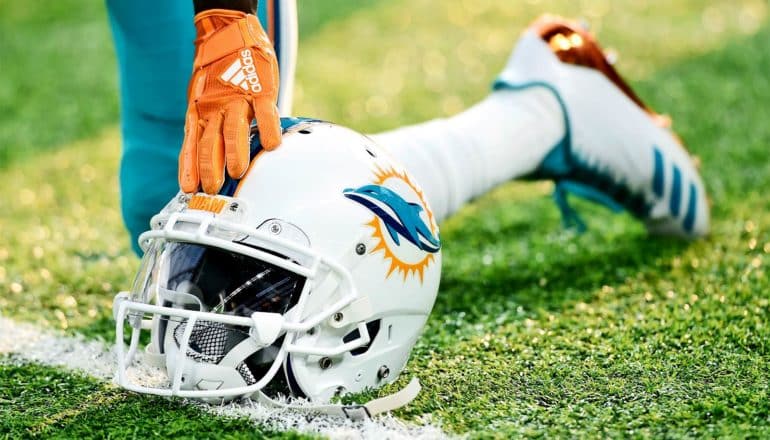
For every year of absorbing the pounding and repeated head collisions that come with playing football, a person’s risk of developing chronic traumatic encephalopathy increases by 30%, according to new research.
For every 2.6 years of play, the risk of developing the condition doubles, the study finds.
These new findings from an analysis of 266 deceased former amateur and professional football players are the first to quantify the strength of the link between playing tackle football and developing chronic traumatic encephalopathy (CTE), a devastating neurodegenerative disease.
A strong link between football and CTE
In a critical distinction between many previous CTE studies, the analysis included dozens of brains of former football players who did not have CTE. That sizable control group provided enough data for the researchers to be confident in their discovery that there is a strong relationship between CTE risk and the number of years a person plays football.
“This study is a testament to the hundreds of families who have donated their loved one’s brain…. It is only because of this support that we can confidently estimate the strength of the relationship between duration of [football] play and risk of CTE,” says corresponding author Ann McKee, chief of neuropathology at VA Boston Healthcare System and director of the Boston University’s CTE Center.
The large number of brain donations has provided the researchers with a big enough sample size (the CTE Center has amassed about 700 brains in total), that they can draw statistically relevant conclusions from their analyses.
“While we don’t yet know the absolute risk of developing CTE among American football players, we now can quantify that each year of play increases the odds of developing CTE by 30%,” says lead author Jesse Mez, director of the Alzheimer’s Disease Center’s Clinical Core and a researcher at the CTE Center. “We hope that these findings will guide players, family members, and physicians in making informed decisions regarding play.”
Time on the field
As part of their analysis, the researchers also looked at other potential variables, including the total number of concussions, football positions played, a person’s age at first exposure to tackle football, their participation in other contact sports, their race, and the presence of other diseases, to see whether those factors had any influence on a person’s CTE risk or, if they were diagnosed with CTE, the severity of their CTE symptoms. They found no associations between these other variables and CTE risk or severity.
But the researchers did find that among players with a CTE diagnosis, their odds of developing severe symptoms of the disease doubled for every additional 5.3 years of football played. Those who played tackle football fewer than 4.5 years were 10 times less likely to develop CTE than those who played longer, although several men who played four years or fewer were diagnosed with CTE, including three whose only contact sport was football.
Those who sustained the longest careers, playing more than 14.5 years, were 10 times more likely to develop CTE than those who played fewer. But the researchers note that several players with football careers longer than 15 years did not have evidence of CTE.
The average length of players’ careers in the National Football League is 3.3 years. But the premature and sudden retirements of a number of stars in the league, including Indianapolis Colts quarterback Andrew Luck, Detroit Lions receiver Calvin Johnson, and New England Patriots tight end Rob Gronkowski, have put renewed attention on the toll the game takes on players’ bodies.
Looking forward
The team drew their findings from analyzing the brains of 223 football players with CTE, and 43 without, from the brain banks at the Veterans Affairs-Boston University-Concussion Legacy Foundation and the Framingham Heart Study, both of which McKee directs. Family members of the deceased provided information about the amount of time that the brain donors spent playing football or other contact sports while they were alive. For former professional players, researchers also consulted an online database.
All of the brains underwent a complete neuropathological evaluation—the researchers did not know of the clinical history of any of the donors before examination—and researchers made CTE diagnoses using well-established criteria.
A major concern of doing CTE research utilizing brain banks is that brain donors—who may pledge their brain tissue based on neurological symptoms they’ve experienced during life—may not be representative of the general population. These factors may bias the relationships being investigated by researchers.
The researchers show in this latest study, however, that the strength of the relationship between CTE and years of football played remained consistent even after they factored in these potentially biasing factors.
Although scientists can currently only diagnose CTE after death, Mez says, “These findings move us closer to diagnosing CTE in life, which is critical for testing potential therapies and for guiding clinical care.”
The research appears in Annals of Neurology.
Funding for the study came from the National Institutes of Health, the Department of Defense, the Department of Veterans Affairs, the Alzheimer’s Association, the National Operating Committee on Standards for Athletic Equipment, the Nick & Lynn Buoniconti CTE Research Fund, the Concussion Legacy Foundation, the Andlinger Family Foundation, WWE, and the National Football League.
Source: Boston University
The post CTE risk goes up 30% for each year of playing football appeared first on Futurity.
from Futurity https://ift.tt/2VvyPzC
No comments:
Post a Comment